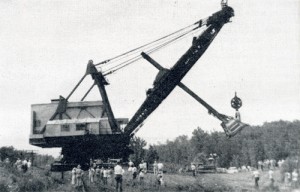Submitted by Dennis Carnal, (a reprint from L&N Magazine, October 1956)

Even if the way is clear, the moving of a 1,200-ton electric shovel some three miles across the county wouldn’t be easy.
Such a three-mile jaunt – made by a 1,200-ton electric shovel, belonging to the Homestead Coal Company, to a new strip mining area at White City, near Morton (now Morton’s Gap), KY, – was climaxed recently by moving the mechanical monster across the L&N main track and U. S. Highway No. 41, south of Morton.
Previously, for the past nine years or so, the big shovel had been hard at work at the Homestead Mine near Nortonville, KY, and had finally worked itself out of a job-temporarily at least.
This big shovel propels itself along on four double sets of caterpillar tracks with its boom facing forward. It is powered by a 5,000-volt electric power supply and drags up to 6400 feet of special high voltage cable. It has a rated capacity of 35 cubic yards of dirt but is normally equipped with a 20-cubic yard bucket whose size can be appreciated by the accompanying picture.
The crossing of our tracks and the highway was planned by Homestead Superintendent Frank Gilbert, working with representatives of the L&N’s maintenance of way department, the Kentucky Highway Department and the American Telephone and Telegraph Company whose lines are on our right of way. Prior to the day set for crossing the tracks, all telephone and signal wires had been replaced with underground cables in pipe conduit; large corrugated pipe had been installed to carry surface water in the various drainage ditches and the approach fill had been constructed. Several hundred cubic yards of dirt were also stockpiled nearby to be used as a “cushion” across the railroad and highway.
To protect the railroad and highway from the enormous weight of the shovel it had been decided to cover them with a four-foot earth fill and, in turn, use 18-inch timber mats on top of the fill for the shovel to move over. With the passing of No. 66, a northbound freight, the big job of filling over the tracks began. About an hour later the shovel was crossing our tracks and the highway was being covered and highway traffic was detoured over the fill covering the railroad. Shortly there after the shovel crossed the highway and connected into a power line previously constructed on that side, thereby clearing the way for the gigantic cleanup job of removing the earth fill from the railroad and highway.
By carefully planning the work and scheduling the time of the crossing, the entire operation was completed in two hours with no delay to trains and a few minutes delay to highway traffic. Several hundred on-lookers were on hand to give the matter their undivided attention and to watch history being made as the Railroad handled its largest movement ever.
Original article by M. W. Cox, Assistant Division Engineer, Evansville, IN.
